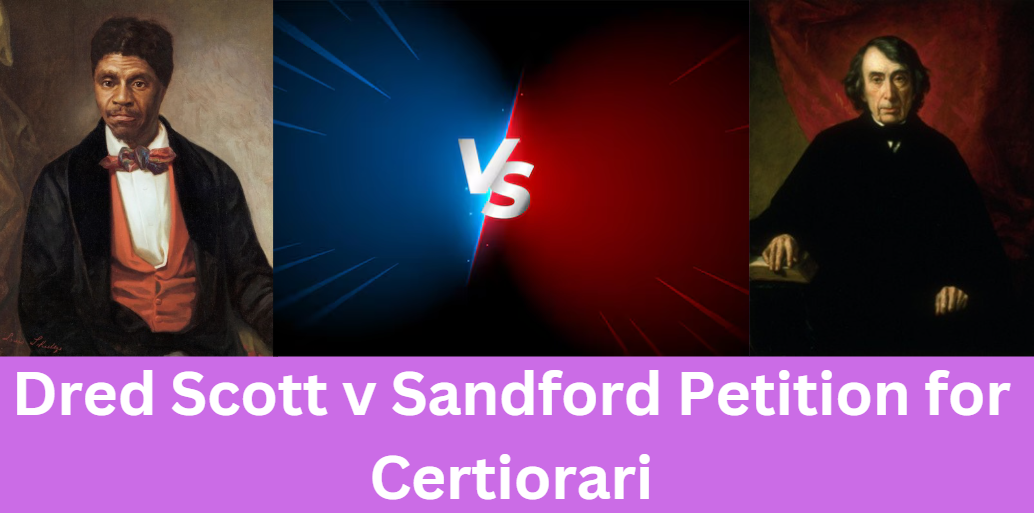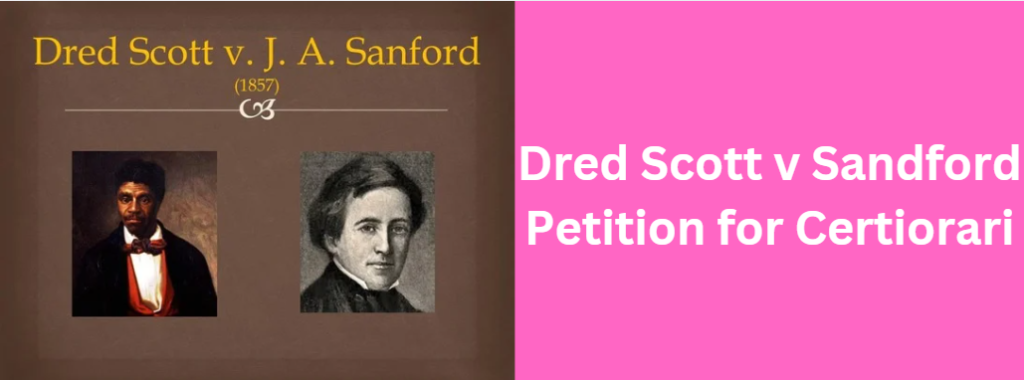
The case of Dred Scott v Sandford remains one of the most infamous and significant decisions in U.S. legal history. The Dred Scott v Sandford petition for certiorari not only marked a turning point in the American legal landscape but also highlighted the deeply entrenched divisions in the nation concerning slavery and civil rights.
The petition, which sought Supreme Court review, ultimately led to a decision that altered the trajectory of U.S. law and politics. This article delves into the history of the case, its legal journey, the Supreme Court’s ruling, and the profound consequences it had on the country.
Historical Background of the Dred Scott Case

To fully understand the significance of the Dred Scott v Sandford petition for certiorari, one must first explore the background of the case. Dred Scott, an enslaved African American man, was born in Virginia in 1795.
Over the course of his life, Scott was transferred to several different territories, including free states, due to the military service of his owner, Army surgeon Dr. John Emerson. Scott’s journey through these free territories raised crucial legal questions about his status as an enslaved person.
In 1846, Scott, with the assistance of abolitionist lawyers, filed a lawsuit in Missouri, claiming that his residence in free territories rendered him a free man. This lawsuit was the beginning of a legal battle that would eventually make its way to the U.S. Supreme Court.
The case was not merely a dispute over Scott’s personal freedom but was intertwined with broader national questions surrounding slavery and the rights of African Americans.
The Legal Journey and the Petition for Certiorari

Initially, Scott filed a lawsuit for his freedom in the Missouri state courts. The lower courts ruled against him, citing the complex laws of slavery and the prevailing judicial attitudes toward African Americans at the time.
Scott’s legal team appealed, arguing that Scott should be free based on his time spent in free territories such as Illinois and Wisconsin.
Eventually, the case reached the Missouri Supreme Court, which upheld the previous decisions, dismissing Scott’s claims. With his legal options exhausted at the state level, Scott and his legal team decided to seek a more far-reaching resolution by petitioning the U.S. Supreme Court.
This marked the formal Dred Scott v Sandford petition for certiorari—a request for the highest court in the land to review the decision made by the lower courts. The petition was an essential legal move, as the Supreme Court’s review could potentially set a precedent for how slavery and citizenship were to be treated across the nation.
The Supreme Court’s decision to grant certiorari to the Dred Scott case was monumental. It was rare for the Court to take up cases that involved such contentious social and political issues, especially those involving slavery and the rights of African Americans.
Yet, in 1856, the Court agreed to hear the case, ultimately leading to one of the most infamous rulings in the history of the American legal system.
The Supreme Court Decision: The Majority Opinion

The case was heard in 1857, and the decision issued by the Supreme Court under Chief Justice Roger B. Taney’s majority opinion became infamous for its sweeping and devastating implications.
In a 7-2 ruling, the Court held that African Americans, whether free or enslaved, could not be considered citizens of the United States and therefore had no standing to sue in federal court. This decision had profound implications not only for Dred Scott but also for the millions of African Americans living in the United States.
The Court’s ruling was rooted in the assertion that African Americans were “so far inferior” that they could not enjoy the rights of citizens. Taney argued that the Constitution, as originally drafted, did not recognize African Americans as part of the political community and that they were not intended to be included in the protections of the Constitution.
Furthermore, the Court declared the Missouri Compromise of 1820 unconstitutional. The Missouri Compromise had attempted to limit the expansion of slavery into certain U.S. territories.
Taney’s opinion held that Congress had no authority to prohibit slavery in the territories, which was a direct challenge to the efforts of abolitionists and those fighting to restrict slavery’s spread.
This decision was highly controversial and was met with immediate backlash from abolitionists, anti-slavery advocates, and the growing Republican Party, which was committed to limiting the expansion of slavery. The decision not only denied Dred Scott his freedom but also further entrenched the nation in the debate over slavery.
The Dissenting Opinions

While the majority opinion in the Dred Scott v Sandford case was authoritative, it was not unanimous. Two justices, Benjamin Robbins Curtis and John McLean, dissented from the majority ruling.
They argued that the Court’s decision was based on a faulty interpretation of the Constitution and that African Americans, even if they were not considered citizens under the law at the time of the founding, should not be permanently excluded from that status.
The dissenting opinions also highlighted the moral and legal flaws of the majority decision. They pointed out that the Constitution’s preamble and the broader ideals of liberty should have been interpreted as offering freedoms and protections to all men, regardless of race.
These dissenting opinions would later be looked upon as prophetic, as they articulated a vision for an inclusive and just legal system, which would ultimately shape the post-Civil War amendments and the nation’s evolution toward civil rights for all people.
Aftermath and Long-Term Consequences

The immediate aftermath of the Dred Scott decision was a nation increasingly divided on the issue of slavery. For many abolitionists, the decision represented a dire threat to the fight for freedom and equality. The decision validated the pro-slavery stance, and it was used to justify the expansion of slavery into new territories and states.
The Dred Scott v Sandford petition for certiorari became a rallying point for anti-slavery advocates, and the case’s ruling only intensified the sectional tensions between the North and South. Within a few years, the United States would be plunged into the Civil War, largely due to the unresolved issues around slavery, which the Dred Scott decision had exacerbated.
Despite the Court’s ruling, the Dred Scott case did not mark the final word on the matter of slavery. The 13th and 14th Amendments to the Constitution, passed after the Civil War, would nullify the Dred Scott decision.
The 13th Amendment abolished slavery, while the 14th Amendment granted citizenship and equal protection under the law to all persons born or naturalized in the United States, including African Americans.
Analysis of the Case’s Legacy

The legacy of Dred Scott v Sandford is one of the most tragic and important lessons in the history of U.S. law. The case serves as a stark reminder of how the legal system can be used to uphold injustice and the consequences of allowing prejudice and discrimination to shape legal interpretations.
The Court’s decision also reveals the limitations of the judicial system when it comes to addressing deeply ingrained social issues.
In the years following the Dred Scott case, the legal and moral arguments presented in the dissenting opinions gained greater prominence. The notion that all men are entitled to liberty and the pursuit of happiness would eventually come to define the nation’s approach to civil rights.
The Dred Scott case, therefore, not only highlighted the legal battles over slavery but also foreshadowed the broader struggle for racial equality in America.
FAQs Related To Dred Scott v Sandford Petition for Certiorari
What was the petition for certiorari in the Dred Scott case?
The petition for certiorari in the Dred Scott v Sandford case was a legal request to the U.S. Supreme Court to review the decision made by the Missouri courts, which had ruled against Scott’s claim for freedom. It marked the beginning of the case’s journey to the highest court in the land.
How did the Dred Scott decision impact the U.S. legal system?
The decision in Dred Scott v Sandford had a profound impact on the U.S. legal system. It solidified the legal foundations of slavery in the territories and denied African Americans citizenship rights. It also contributed to the intensifying conflict between free and slave states, ultimately leading to the Civil War.
Why is Dred Scott v Sandford considered a controversial ruling?
The ruling is considered controversial because it denied basic human rights and citizenship to African Americans, reinforcing a system of racial inequality. It is seen as a moral and legal failure that directly contradicted the nation’s founding principles of liberty and equality.
What role did this case play in the lead-up to the Civil War?
The Dred Scott decision exacerbated sectional tensions between the North and South. By declaring the Missouri Compromise unconstitutional, the decision fueled the growing divide over the issue of slavery and helped catalyze the events leading to the Civil War.
Conclusion About Dred Scott v Sandford Petition for Certiorari
The Dred Scott v Sandford petition for certiorari was not just a legal maneuver but a pivotal moment in American history that reverberated through the nation’s legal and political systems.
While the decision itself was a step backward for civil rights, it also contributed to the moral and legal debates that would lead to the abolition of slavery and the establishment of equality under the law.
The lessons of Dred Scott are as relevant today as they were in the mid-19th century, reminding us of the critical role of the legal system in shaping social justice and equality.
Affiliated Posts Like Dred Scott v Sandford Petition for Certiorari
Matz Cello Quartet in D Minor Atlanta Symphony Orchestra
New World Aeternum US East Pangea Trading Post: A Complete Guide





